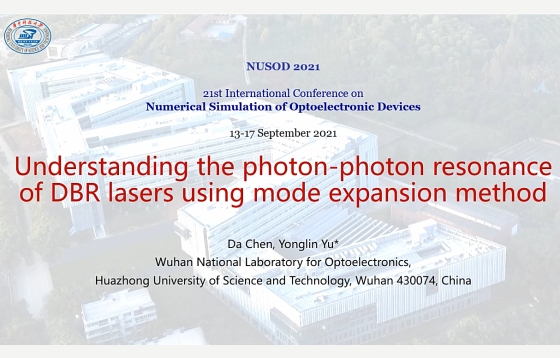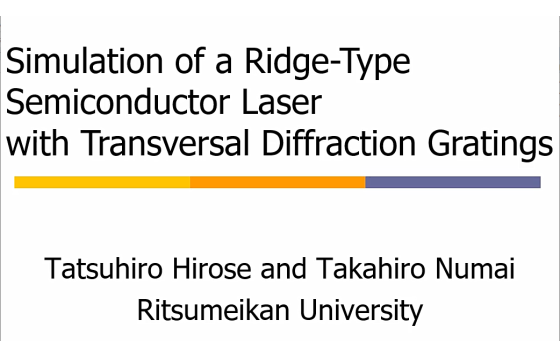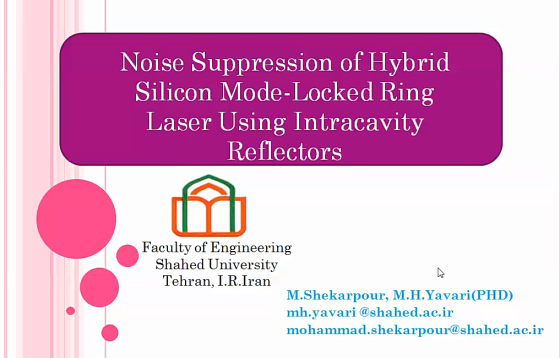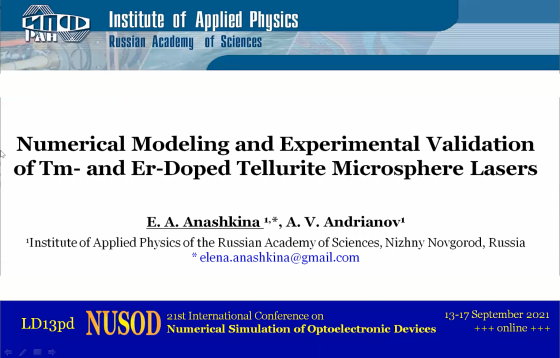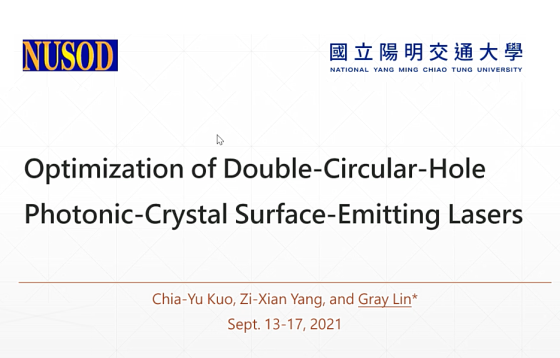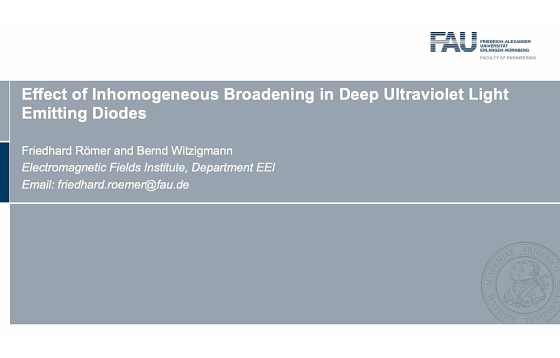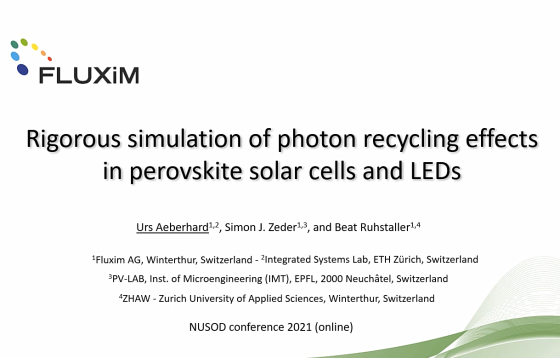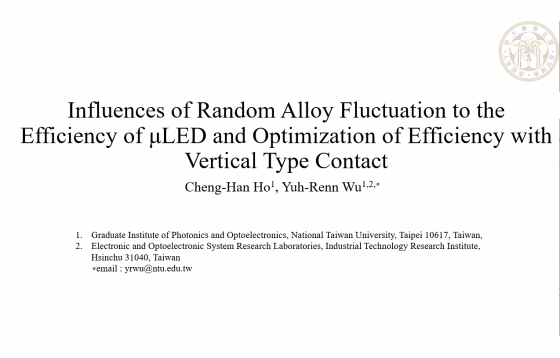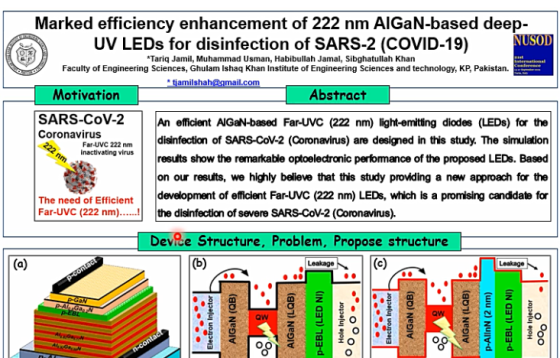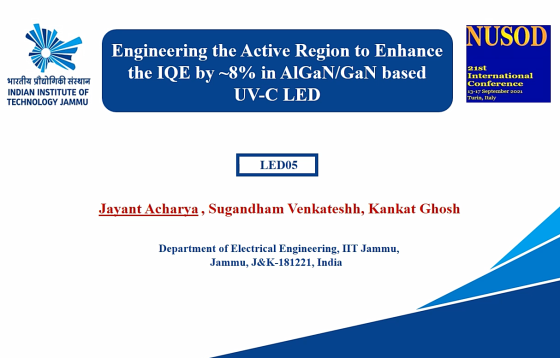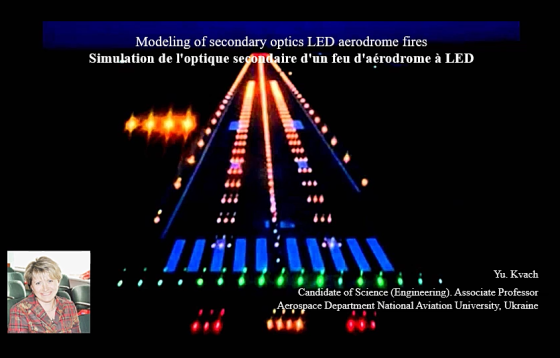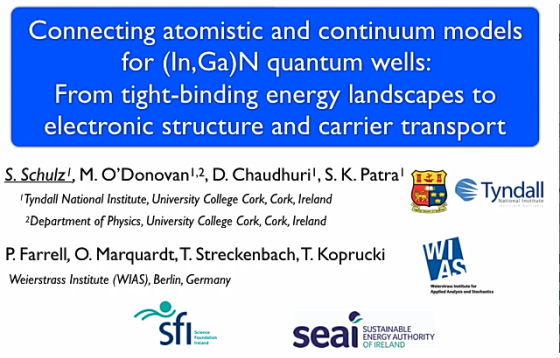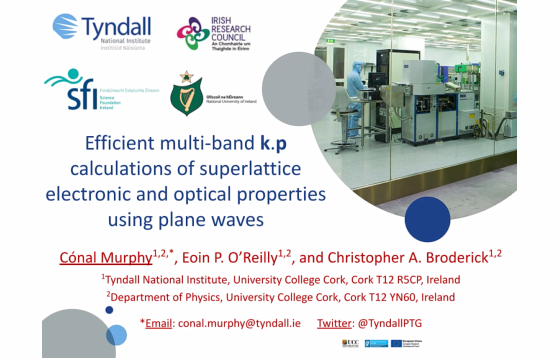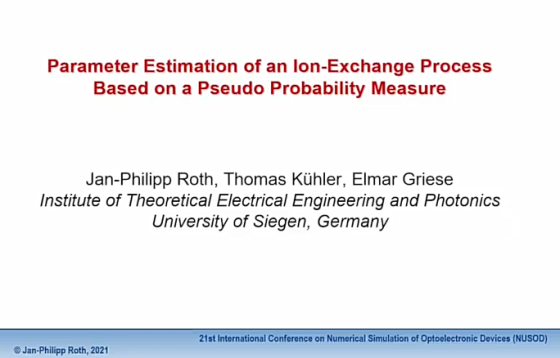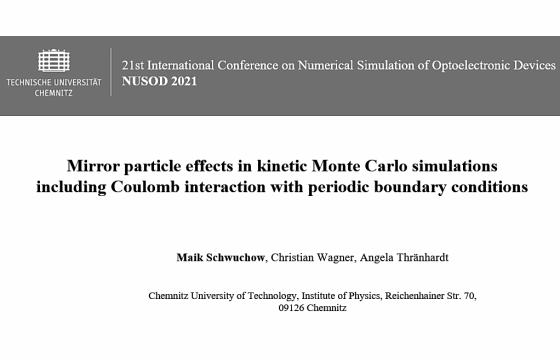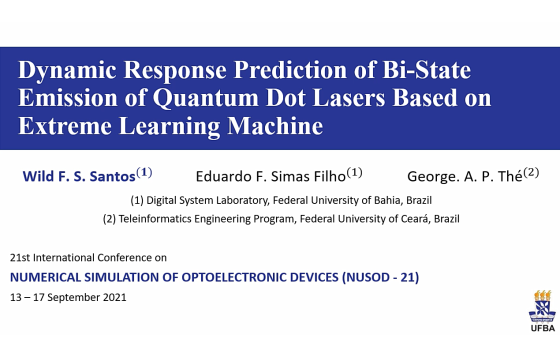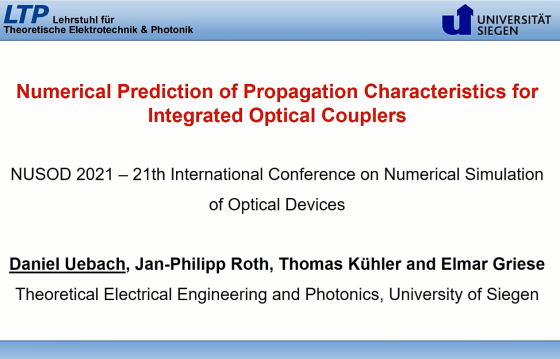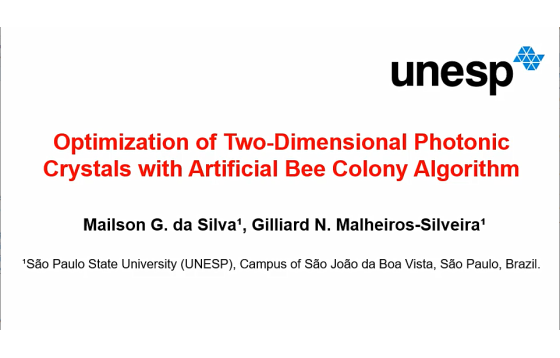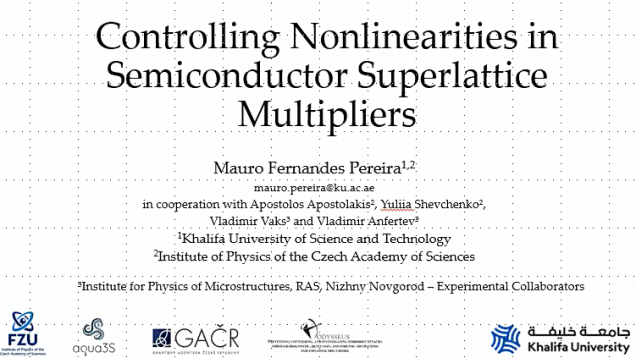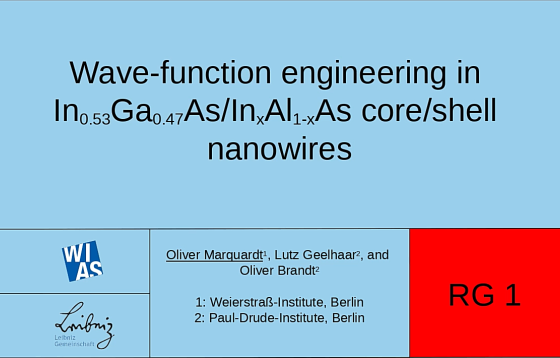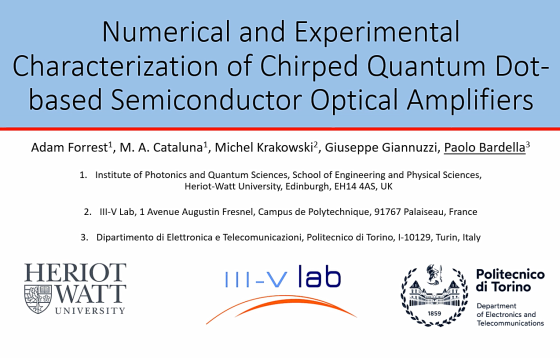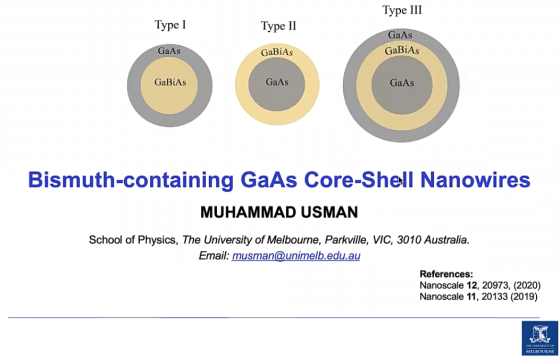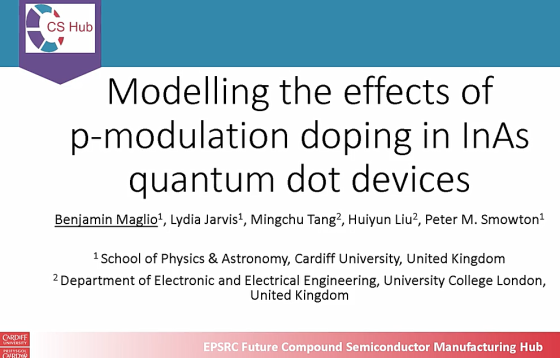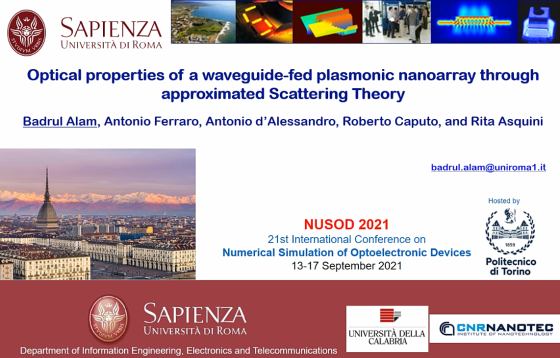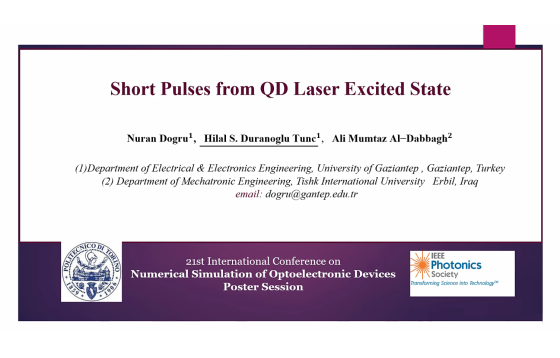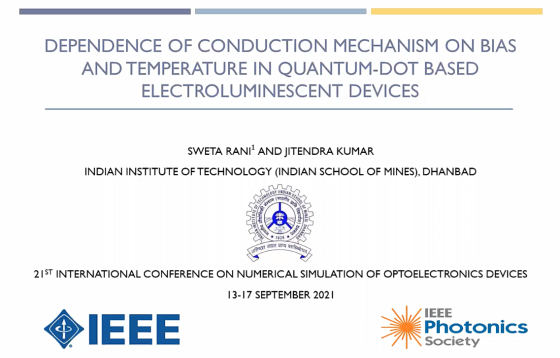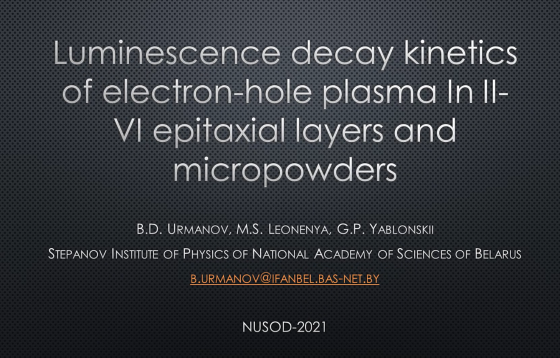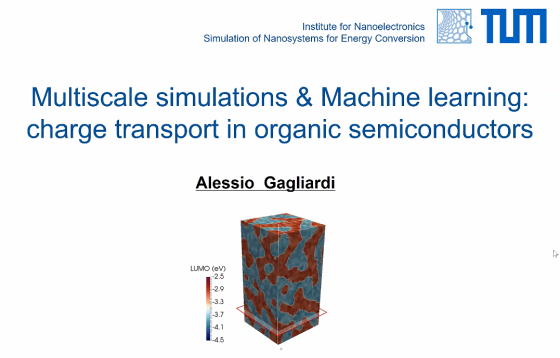


Photon-photon resonance (PPR) in DBR lasers is studied by numerical simulations, which are based on the mode expansion and the rate equations. It is found that the photon number and the mode coupling factor play important roles to understand physical mechanism of the PPR behind.
LD10–Optical Feedback Regimes Suitable for Distance Measurement with a Ring Laser
We numerically study the behavior of a ring laser subject to bidirectional delayed optical feedback, when the isolated laser is in the quasi-unidirectional regime. We find different regimes, two of which are of special interest, because the laser switching period, between the clockwise and the counter-clockwise mode, is linearly related to the time of flight […]
LD11–Simulation of a Ridge-Type Semiconductor Laser with Transversal Diffraction Gratings
This paper reports on improvement of stability of the fundamental horizontal transverse mode in a ridge-type semiconductor laser by incorporating transversal diffraction gratings. Kinks do not appear in current versus light-output curves by appropriately designing the number of the grating periods when the mesa width is 5 µm.
LD12–Noise Suppression of Hybrid Silicon Mode-Locked Ring Laser Using Intracavity Reflectors
We have proposed harmonically hybrid silicon mode-locked ring laser using intracavity reflectors (ICR’s) to suppress supermode noise. The dynamic and noise propertiesof ring laser for without-reflector structures (WOICRS) and proposed structure (PS) are investigated using a delay differential equation model (DDE).
LD13pd–Numerical Modeling and Experimental Validation of Tm- and Er-Doped Tellurite Microsphere Lasers
We report an efficient semi-analytical method for modeling of CW rare-earth ion-doped microlasers. We numerically simulated threshold pump powers and expected laser wavelengths for in-band pumped Tm- and Er-doped tellurite glass microspheres. With the increase of Q-factor, the laser wavelength grows smoothly for Tm and there are jumps from the C-band to the L-band for […]
LD14pd–Optimization of Double-Circular-Hole Photonic-Crystal Surface-Emitting Lasers
Photonic-crystal surface-emitting lasers (PCSELs) with double circular holes in the unit cell are optimized in terms of slope efficiency and single-mode stability. For PC-SELs with double-hole shift of one-fourth and one-third lattice constant, the area ratios of two holes are optimized separately and fall in completely different range; moreover, their threshold gain discrimination values are […]
LED01–Effect of Inhomogeneous Broadening in Deep Ultraviolet Light Emitting Diodes
Due to their small dimensions deep ultraviolet (DUV) light emitting diodes (LED) are highly attractive light sources for environmental and medical applications. DUV LEDs generate light in active quantum wells (QW) made of Aluminium Gallium Nitride. The QWs are not lattice matched to the substrate and only few monolayers thick making them susceptible to compound […]
LED02–Rigorous simulation of photon recycling effects in perovskite solar cells and LEDs
Secondary photogeneration due to reabsorption of internally emitted photons in metal halide perovskites is assessed using a novel dipole emission model that is compatible with detailed balance rates. The model considers the non-uniform local photon density of states of thin film absorbers/emitters consistently in internal and external emission and provides insight into the impact of […]
LED03–Influences of Random Alloy Fluctuation to the Efficiency of micro-LED and Optimization of Efficiency with Vertical Type Contact
µ-LED’s efficiency is enormously dependent on the chip size, which is believed to be the influence of sidewall traps. However, the decrease of IQE in AlInGaP based red LED is much stronger than nitride based LEDs. This paper examines the role of random alloy fluctuation with our 2D simulation software for the whole LED chip […]
LED04–Marked efficiency enhancement of 222 nm AlGaN-based deep-UV LEDs for disinfection of SARS-2 (Covid-19)
The AlGaN-based deep ultraviolet light emitting diodes (DUV LEDs) for the disinfection of SARS-2 (Covid-19) are proposed in this study. The optoelectronic characteristics of DUV LEDs are numerically analyzed. The results show that the internal quantum efficiency (IQE) and radiative recombination rate are excellently improved in the proposed LED. This significant enhancement is due to […]
LED05–Engineering the Active Region to Enhance the IQE by ~8% in AlGaN/GaN based UVC LED
To increase the internal quantum efficiency (IQE) of AlGaN/GaN based multi quantum-well (MQW) UV-C LED, the aluminium composition of barriers and wells in the active region has been engineered. Increase in electron-hole overlap and hence the radiative recombination rate in the final engineered structure has enabled to enhance the IQE by 8%.
LED06–Modeling of secondary optics LED aerodrome fires
The development of LED technology has allowed the Ukrainian Association of Lighting Enterprises of Vatra Corporation to develop the construction of LED equipment for the airfield light signal systems. Features of fire design, angles of installation of fires, difficulties in observing LED aerodrome fires – these factors influence the decision making when establishing visual contact. […]
MM01–Connecting atomistic and continuum models for (In,Ga)N quantum wells: From tight-binding energy landscapes to electronic structure and carrier transport
We present a multi-scale framework for calculating electronic and transport properties of nitride-based devices. Here, an atomistic tight-binding model is connected with continuum based electronic structure and transport models. In a first step, the electronic structure of (In,Ga)N quantum wells is analyzed and compared between atomistic and continuum-based approaches, showing that even though the two […]
MM02–Efficient multi-band k·p calculations of superlattice electronic and optical properties using plane waves
Solving the multi-band k·p Schrodinger equation for a quantum-confined heterostructure using a reciprocal space plane wave approach presents several advantages compared to conventional real space approaches such as the finite difference or element methods. In addition to allowing analytical derivation of the heterostructure Hamiltonian, a desired level of accuracy in the computed eigenstates can generally […]
MM03–Parameter Estimation of an Ion-Exchange Process Based on a Pseudo Probability Measure
For the realization of integrated optical waveguide components, needed for integrated photonic circuits, a promising approach to manufacturing is their embedding in thin glass sheets by thermal diffusion processes. Because prototyping or manufacturing small batch series is costly, appropriate numerical simulations are used in order to allow an accurate characterization. However, in practical applications it […]
MM04–Mirror particle effects in kinetic Monte Carlo simulations including Coulomb interaction with periodic boundary conditions
We investigate the photoluminescence of low-dimensional disordered materials, as used e.g. in solar cells, by performing kinetic Monte-Carlo simulations of exciton hopping with periodic boundary conditions. In order to perform numerically efficient calculations, the box length Lbox should be as small as possible while maintaining physically meaningful results during the presence of exciton-exciton-interaction. Exciton-exciton interaction […]
MM05–Dynamic Response Prediction of Bi-State Emission of Quantum Dot Lasers Based on Extreme Learning Machine
Dual-state emission is an phenomenon which takes place in Quantum Dot Lasers at different temperature and operating conditions. In this study, we investigate that issue from a nonlinear regression model based on Extreme Learning Machine, which revealed to be able to predict the spectrally resolved transient response of InAs/InGaAs quantum dot laser with error performance […]
MM06–Numerical Prediction of Propagation Characteristics for Integrated Optical Couplers
The field-assisted ion-exchange process for manufacturing integrated optical couplers is multivariate. For this reason, a precise prediction of the optical propagation characteristics of manufactured devices is needed. Two numerical calculation methods are compared with measured results for an integrated coupler to assess its applicability for a precise prediction.
MM07–Optimization of Two-Dimensional Photonic Crystals with Artificial Bee Colony Algorithm
We applied the Artificial Bee Colony algorithm for the complete band gap maximization of a two-dimensional photonic crystal. The band diagram and band gap calculation were carried out by the software MIT Photonic Bands, and these results were used in the algorithm’s fitness function. The optimum structure was compared to the literature which used genetic […]
MM08–Controlling Nonlinearities in Semiconductor Superlattice Multipliers
A hybrid approach combining Nonequilibrium Green’s Fuctions with solutions of the Boltzman equation, delivers voltage and intrinsic asymmetry control of nonlinearities in semiconductor superlattices. Unexpected nonlinear behavior is predicted for high harmonics as a result of voltage control.
N01–Nanowire antennas embedding single quantum dots: towards the emission of indistinguishable photons
Nanowire antennas embedding a single semiconductor quantum dot (QD) represent an appealing solid-state platform for photonic quantum technologies. We present recent work aiming at generating indistinguishable photons with this system. We first investigate decoherence channels that spectrally broaden the QD emission, and discuss in particular the impact of nanowire thermal vibrations. We also develop nanowire […]
N02–Wave-function engineering in (In,Ga)As/(In,Al)As core/shell nanowires
We study the electronic properties of In0.53Ga0.47As/InxAl1–xAs core/shell nanowires for light emission in the telecommunication range. In particular, we systematically investigate the influence of the In content x of the InxAl1–xAs shell and the diameter d of the In0.53Ga0.47As core on strain distribution, transition energies, and the character of the hole wave function. We show […]
N03–Numerical and Experimental Characterization of Chirped Quantum Dot-based Semiconductor Optical Amplifiers
We present a model for the description of the dynamical behavior of Quantum Dot (QD) based Semiconductor Optical Amplifiers (SOAs) under injection of optical pulses. The model uses a Time Domain Traveling Wave (TDTW) approach to describe the optical field in the amplifier, and allows us to consider chirped QD materials by the inclusion of […]
N04–Bismuth-containing GaAs core-shell nanowires
This work theoretically investigates the electronic and optical properties of GaBixAs1–x/GaAs core–shell and GaAs/GaBixAs1–x/GaAs multi-core–shell nanowires. Our results show a large tuning of absorption wavelength (0.9 µ to 1.6 µ) by varying Bi composition and/or nanowire diameters. The computed polarisation dependent optical spectra indicate the possibility to incorporate such nanowires in photonic devices desiring isotropic […]
N05–Modeling the effects of p-modulation doping in InAs quantum dot devices
A modeling routine has been developed to quantify the effects of p-modulation doping in the waveguide core region of InAs quantum dot (QD) devices. Utilizing one dimensional approximations, simulated outputs of reverse and forward devices are simulated providing insight into absorption and gain properties.
N06–Optical properties of a waveguide-fed plasmonic nano-array through approximated scattering theory
We analyze the optical scattering properties of an array of Au nano-cylinders fabricated upon an ion-exchanged waveguide. The integrated systems is considered for fluoroscopy and Raman spectroscopy. Absorption, scattering and extinction have been calculated through a combination of Finite Difference Time Domain (FDTD) method and scattering theory. While a portion of the excitation signal interacts […]
N07–Short Pulses from QD Laser Excited State
For the first time gain-switched short pulse generation with a width of 25-40 ps from excited state is demonstrated applying an external optical Gaussian beam to the excited state of InAs-InP-(113)B quantum dot laser.
N08–Dependence of conduction mechanism on bias and temperature in quantum-dot based electroluminescent devices
Quantum dots (QDs) provide some unique properties which make them preferable over other luminescent materials, one such property being adjustable and sharp emission which makes it an interesting candidate for electroluminescent devices. A QD based electroluminescent device has been taken into consideration in this theoretical study. The effect of the bias, temperature, the presence of […]
N09–Luminescence Decay Kinetics of Electron-Hole Plasma in II-VI Epitaxial Layers and Micropowders
The luminescence decay kinetics of epitaxial layers of ZnSe and micropowders of ZnSe and CdS were measured at room temperature and at high levels of optical excitation. Comparison of the experimental results with the theoretically calculated decay kinetics showed good agreement for the initial moment of time at high concentrations of nonequilibrium charge carriers.
NM01–Machine Learning & multiscale simulations: toward fast screening of organic semiconductor materials
Organic semiconductor devices promise cost-efficient processability at low temperatures, but the usually amorphous materials suffer from low charge carrier mobility. The search for high mobility organic semiconductor materials has thrived data science and Machine Learning approaches to screen the vast amount of possible organic materials. We present a multiscale simulation model based on machine learned […]

